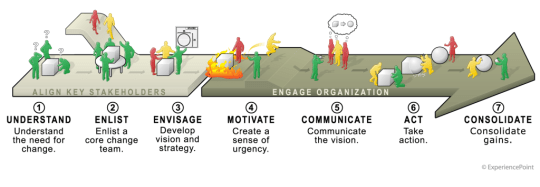How often do we hear stories where Lean seems to be floundering in an organization?
Leaders often complain:
“People are being resistant to Lean.”
Ah, that sounds like a variation on the old complaint that “people are resistant to change” or that “people hate change.”
I don't believe that people hate change.
I think people hate being uncomfortable when there are changes promised (or happening) that they don't understand. I think people hate being told to change when they don't think it's really an improvement. Or they hate change when they're going to be forced to “sustain” a practice instead of testing it to see if it's really worth sustaining. People hate not having input into change.
Hear Mark read this post (subscribe to the podcast):
If Lean is this mysterious thing that's not being communicated well, people are going to resist that. You can't blame them. You can, perhaps, blame leadership for not leading.
I finally read the outstanding book by Chip and Dan Health: Switch: How to Change Things When Change Is Hard. Dozens of people have recommended this book and I finally got to it. I wish I had read it earlier.
There are many gems in the book.
One is, and I'm paraphrasing I think, change is a process, not an event. Ironically, change is not like flipping a switch.
We shouldn't expect people to believe in Lean overnight. One training class doesn't do it. One speech from an executive doesn't do it.
As the Heath brothers say:
“Knowledge does not change behavior.”
There's got to be more to change than logic. There must be an emotional appeal as well.
Why do people “resist” small changes or a big programmatic change like Lean?
“What looks like resistance is often a lack of clarity.”

One thing we need is to know WHY we need to change. Simon Sinek makes this very clear in his book Start with Why: How Great Leaders Inspire Everyone to Take Action. Listen to a podcast that my friend Ron Pereira did with Simon last week through his Gemba Academy Podcast.
When I look at “Lean failures” (or situations that might become failures), there seem to be some trends:
- Lack of communication
- Lack of understanding WHY Lean is needed (what problem are we trying to solve?)
- The urgency for change is not well understood
- Often, Lean itself is not well understood
When I was leading Lean transformation projects in hospitals 10 years ago (through a consulting arm of J&J), we weren't just teaching Lean… we had a pretty good change management methodology in place. We were basically using the John Kotter change model, made famous in his article, then book, Leading Change.
We were trying to avoid the 8 mistakes that Kotter laid out in the article:
- Allowing too much complacency
- Failing to create a sufficiently powerful guiding coalition
- Underestimating the power of vision
- Undercommunicating the vision by a factor of 10 (or 100 or even 1,000)
- Permitting obstacles to block the new vision
- Failing to create short-term wins
- Declaring victory too soon
- Neglecting to anchor changes firmly in the corporate culture
Do you make any of those mistakes?
Adopting Lean in an organization is a major change, just like implementing an EMR system, merging with another health system, or building a new hospital or tower.
A common thread in successful changes is a solid change management methodology. There are no silver bullets, but the recognition that change is hard and that change sometimes can't be rushed is key.
A New Workshop I'm Facilitating
Because I see change management as being so important (or the lack of good change leadership being so harmful), I've partnered up with ExperiencePoint, a company that has created a very effective approach to learning change management practices in a safe, experiential way. I first learned about them in 2009, when I first got to experience their “Lakeview” change simulation when it was new.
Lakeview is a scenario and case based on improving patient flow in a hospital, using Lean as a strategy. I liked the ExperiencePoint approach and I've followed their progress. I finally decided to get certified so I could bring Lakeview, or their other simulation called GlobalTech, to my clients and other organizations.
Last week, I got some practice facilitating the Lakeview simulation with a volunteer audience of local friends from different organizations. During the full-day workshop, people worked in teams of 3 or 4 people, working the case scenario through their table discussions and interactions with the simulation software. I facilitated discussions and taught a change management model that they could use in the scenario (and take back to their workplace). The team working time is about 3 hours of the experience. It's definitely not a full day of didactic learning.
The model that ExperiencePoint recommends is a modification of the Kotter change model. Kotter says that the first step should be to build a sense of urgency. I agree with the ExperiencePoint folks that a better first step is to understand the situation and the need for change. That seems like good Lean thinking to me, by the way. If you start by communicating a sense of urgency, you might just build anxiety if you haven't communicated anything about how to solve the problem.
Here is the ExperiencePoint model that we use (click for a larger view):

- Understand the need for change
- Enlist a core change team
- Envisage: Develop the vision and strategy
- Motivate: Create a sense of urgency (more broadly in the organization)
- Communicate the vision
- Act: Take action
- Consolidate gains
Many organizations are in a rush and jump to phase six… they are jumping to solutions without first laying the groundwork and foundation for change to be understood and accepted.
Having a model like this helps prevent errors, such as jumping to implement Lean tools before the organization understands WHY change is necessary. You have to engage and enroll people in change, not just force things on them.
I am convinced that the ExperienceChange simulations, either Lakeview or GlobalTech, are a great way to learn and practice. It's a great team building activity and a way of building some common language and methodology that can be used to better implement changes in the future.
If you'd like to learn more about this or about bringing this learning experience to you organization, please click here for the ExperienceChange page on my website.
Even if you're not interested in the workshop or approach, what do you think about the broader points that I brought up here in the post?
Please scroll down (or click) to post a comment. Connect with me on LinkedIn.
Let’s work together to build a culture of continuous improvement and psychological safety. If you're a leader looking to create lasting change—not just projects—I help organizations:
- Engage people at all levels in sustainable improvement
- Shift from fear of mistakes to learning from them
- Apply Lean thinking in practical, people-centered ways
Interested in coaching or a keynote talk? Let’s start a conversation.







![When Was the Last Time a Leader Around You Admitted They Were Wrong? [Poll]](https://www.leanblog.org/wp-content/uploads/2025/07/Lean-Blog-Post-Cover-Image-2025-07-01T212509.843-238x178.jpg)


![When Was the Last Time a Leader Around You Admitted They Were Wrong? [Poll]](https://www.leanblog.org/wp-content/uploads/2025/07/Lean-Blog-Post-Cover-Image-2025-07-01T212509.843-100x75.jpg)


Good article Mark. Of course, the critical element in change leadership is for leadership to change first. Too often we see senior folks trying to force the rest of the organization to change its processes and culture, but are unwilling to change anything they do, and see themselves as exempt from the cultural rules everyone else is expected to follow.
Yeah, it doesn’t work if leaders say “Let’s change… you go first!”
I agree, the problem isn’t change but the process for change. There are many smart things to do to help the process work better.
The most important thing though is the entire management culture. Tactics can help change work better. But if the culture is hostile to continual improvement (fear based, performance appraisal based, target based, blame based, imposing from on high…) the tactics are working in a difficult situation. Still, a good idea, but no matter what tactics are used it will be a challenge.
When the culture has the right environment (PDSA, seek to continually improve the system, respect for people, support for innovation, understanding of variation in results, seek process weakness to improve not people to blame…, provide training…) change is set in a system where resistance is much lower (and in very highly functioning systems it is encouraged not resisted).
Change tactics are still sensible but often they are baked into how things are done. As you grow more toward becoming such an organization change tactics fade into the normal process and the resistance fades too.
John, some of the things you mention seem like root causes of “resistance to change” — I’d include a lack of trust and a lack of leadership.
I don’t think change management methods would work if you’re putting new tile on top of rotting subflooring… but if there’s a good foundation, I think it’s helpful to have “standardized work for leading change,” if you will. What starts as the conscious use of a method could turn into unconscious competence as this stuff becomes second nature?
I agree they can be seen as root causes. Certainly counter-measures can address the situation to not only improve this change attempt but all future change attempts. The degree of interaction is large too. The same tactics if employees trust managers (based on lots of past history) are much more effective than if they don’t trust their manager.
And I do completely believe you develop patterns of thinking and behavior based on your experience that do make things unconscious (second nature). Unfortunately this works not only for good behaviors but bad ones too :-/
Hi Mark,
Kudos for this post!
I’ll share it on Linkedin and Twitter.
Greetings from Holland,
Iris
founder of The Lean & Six Sigma Daily
Thanks, Iris! I’ve enjoyed my two visits to Holland in the past. There’s a lot of great Lean healthcare improvement work taking place there!
Mark, very good. I love the 7 step visual. I think that it helps show the importance of sequentially following some key PDCA discipline. Frequently people are eager to try something before the current situation is fully understood. John Rinke
Here’s a nice blog post by my friend David Skinner, who has also gotten certified to facilitate this workshop (primarily for law firms).
[…] Learn more via this blog post and the link below: […]
Here is a webinar and demo I did about the workshop and simulation:
[…] I’ve blogged before about facilitating the fun and exciting “ExperienceChange” wor…. […]